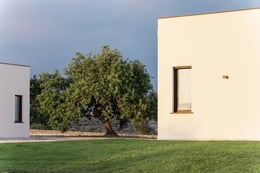Login
Registered users

This vacation home combines formal rigor with a commitment to sustainability and reduced environmental impact. Its location – a country landscape in Ispica Municipality not far from Sicily’s Mediterranean Coast, nestled among cultivated land, olive groves, carob trees and the nearby sea-dominated horizon – makes it something of a landmark construction. The home offers total floorspace of 250 sq. m over a single floor, in a large plot surrounded by a traditional local dry-stone wall. Immersed among mature carob trees, the home’s shape follows the promptings of nature, vegetation, the surrounding colors, earth and stones. The colors chosen for the home’s exterior walls highlight the material effects of minor nuances typical of the local stone used for the dry-stone walls encircling the property. By following such an approach, this example of architecture takes its place naturally and lightly within the natural context. Indeed, it almost looks as if the home emerged spontaneously from the surrounding environment, vegetation and terrain. The building stands on a natural stone base that rises discreetly from the land and surrounding greenery, highlighting the project’s underlying linearity within a context characterized by horizontal lines on the slightly sloping terrain. The house consists of a main longitudinal body plus an outbuilding to the north, a guest facility set in a parallelepiped with relatively blind walls. The home’s hallmark feature is its south-facing elevation, most notably its ample-glazed walls set in burnished frames – the color of which is redolent of the hues of the surrounding carob tree trunks – that ensure significant quantities of light penetrate the interior. Climate-wise, the south-facing exposure accumulates heat during the winter months; in the summers, external sun blinds in thermal break housings limit the impact of sunshine.
The central nature of the living and dining room is evident in the plan, in which they are separated off from the side portions at either end (occupied by three bedrooms: the main bedroom to the east, the other two bedrooms facing west). The kitchen is sited in an equally distinguishable part of the building set back to the north, along a glazed corridor propelled towards the outside, across the separation between the two blocks, connecting the internal spaces. Another of the home’s hallmark features is an infinity pool nestled within the arms of the southern elevation. A complement to the house, the swimming pool is set into its base; slabs of the very same stone form its light-hued bottom, which reflects the Sicilian skies in its waters.
The project was designed to minimize the construction’s impact on the environment compositionally (after meticulous surveying the buildings’ relationship with the vegetation) and in terms of its thermal and energy impact. By using the most appropriate materials and a thermal insulation system based on varying thicknesses of wood fiber, the house achieves admirable micro-climatic conditions and was built to CasaClima A certification standard.

























Location: Ispica (RG)
Client: Private
Completion: 2019
Gross Floor Area: 250 m2
Architects: ARCstudio Perlini
Works Management: Michele Perlini
Doors and Windows Frames: Schüco by Peloso Infissi
Photography: © Giancarlo Tinè, courtesy Michele Perlini
ARCstudio Perlini
Born in 1982 in Verona, Italy, Michele Perlini graduated in Sustainable Architecture from the IUAV University of Venice in 2007. He has worked at the family practice in Verona since 2005. Originally founded in 1974, the practice specializes in low-energy sustainable architecture and design. In 2009, Michele obtained his CasaClima Expert Consultant Diploma.
His most important works to date include Italy’s first ever CasaClima A-Class Nature-certified restoration and conservation project, and the nation’s first CasaClima Welcome-certified luxury hotel. He was also responsible for a new sustainable prototype of Mies van der Rohe’s Farnsworth Home.
In 2014, Michele designed and produced Smart House®, a new template for CasaClima-certified sustainable homes. He has edited sustainable architecture columns for the Casa Naturale and dentroCASA magazines, attended major domestic conferences as a CasaClima expert consultant, and designed a number of furniture collections that have been shown at the 100% Design show in London, and the Salone del Mobile in Milan.
In 2018, he designed, patented and presented the Eden Luxury Portable Suite, which won the Iconic Awards international prize in Munich for the Innovative Architecture category. In 2019, he came up with the No.Made Luxury Mobile Home, which resulted in him winning the same prize for a second time. Both of these designs were displayed at the Milan Fuorisalone event in the years they were created.
Michele also won the cubo d’oro, which is considered to be the Oscar of sustainability, at the 2016 CasaClima Awards. In 2019, he was a finalist in the Architizer A+ Awards in New York.
His designs have featured in major Italian and international architecture magazines.